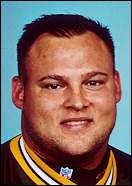 Osborne in 2000 | |||||||
| No. 97, 98 | |||||||
|---|---|---|---|---|---|---|---|
| Position: | Defensive tackle | ||||||
| Personal information | |||||||
| Born: | November 2, 1973 Los Angeles, California, U.S. | ||||||
| Died: | October 16, 2012 (aged 38) La Jolla, California, U.S. | ||||||
| Height: | 6 ft 2 in (1.88 m) | ||||||
| Weight: | 295 lb (134 kg) | ||||||
| Career information | |||||||
| High school: | Santa Clarita (CA) Canyon | ||||||
| College: | Arizona | ||||||
| NFL draft: | 1996 / Round: 7 / Pick: 222 | ||||||
| Career history | |||||||
| Career NFL statistics | |||||||
| |||||||
| Player stats at NFL.com · PFR | |||||||
Charles Wayne Osborne Jr. (November 2, 1973 – October 16, 2012) was an American football defensive tackle who played five seasons in the National Football League (NFL) with the St. Louis Rams and Oakland Raiders. He was drafted by the St. Louis Rams in the seventh round of the 1996 NFL Draft. [1] The 1996 NFL combine scored "Chuck" the strongest at 33 reps (225 lb). He played college football at the University of Arizona with the famed "Desert Swarm" defense and attended Canyon High School in Santa Clarita, California. [2] Osborne was also a member of the Amsterdam Admirals, Green Bay Packers, and the New England Patriots. [3]
Osborne died at his home in La Jolla, California on October 16, 2012. His cause of death was listed as " CTE and obesity-related hypertensive cardiomyopathy." [4] He is one of at least 345 NFL players to be diagnosed after death with CTE, which is caused by repeated hits to the head. [5] [6]
References
- ^ "1996 NFL Draft Listing". Pro-Football-Reference.com. Retrieved 2023-03-30.
- ^ "CHUCK OSBORNE". profootballarchives.com. Archived from the original on November 29, 2014. Retrieved November 13, 2014.
- ^ "Arena Football League Transactions". www.oursportscentral.com. OurSports Central. March 25, 2002. Retrieved July 22, 2017.
- ^ "Former Canyon star was casualty of sport". signalscv.com. November 9, 2013. Retrieved November 13, 2014.
- ^ "The driving force behind Chronic Traumatic Encephalopathy (CTE)". Concussion Legacy Foundation. Retrieved July 2, 2023.
- ^ Ken Belson and Benjamin Mueller (June 20, 2023). "Collective Force of Head Hits, Not Just the Number of Them, Increases Odds of C.T.E. The largest study of chronic traumatic encephalopathy to date found that the cumulative force of head hits absorbed by players in their careers is the best predictor of future brain disease". The New York Times. Retrieved July 2, 2023.
- https://nflcombineresults.com/playerpage.php?f=Chuck&l=Osborne&i=23358
- http://tucsoncitizen.com/wildcatreport/2012/10/17/chuck-osborne-unsung-hero-of-arizonas-desert-swarm-dies-at-38/
- https://www.facebook.com/charleswayneosborne/
- https://www.foxsports.com/arizona/story/desert-swarm-mourns-tough-guy-osborne-101712
External links
- 1973 births
- 2012 deaths
- Players of American football from Los Angeles
- American football defensive tackles
- Arizona Wildcats football players
- St. Louis Rams players
- Amsterdam Admirals players
- Oakland Raiders players
- Deaths from hypertension
- Georgia Force players
- Burials at Forest Lawn Memorial Park (Hollywood Hills)
- Deaths from cardiomyopathy
- Players of American football with chronic traumatic encephalopathy
- Deaths from dementia in California
- American football defensive lineman, 1970s birth stubs